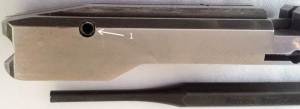Dry fire practice is not only the least expensive method of your marksmanship training, it is also the most valuable. Every interview or article I’ve seen or read by a world class competitor includes the point that he takes more than 100, sometimes even 500, dry-fire shots for every live round fired in practice. Whether you are a target competitor, a hunter, or a plinker (perhaps you bet your buddies you can hit that quarter at 25 yards, or that pop can at 100), dry-fire practice will make you a more accurate marksman.
You can safely dry fire your 10/22. Some wise old shooters say that you can’t dry fire a .22 because it will damage the firing pin, the breech of the barrel, or both. This is true of many older rimfire arms which have nothing to stop the firing pin from hitting the barrel if the chamber is empty. But the 10/22 is designed to be dry fired safely. As you can see from the photos below, the firing pin has a hole in it (2 in left photo) through which the firing pin stop pin (1 in right photo) sits crosswise.
When you drop the hammer on an empty chamber, the firing pin’s forward motion is stopped by that stop pin just short of the bolt face. In a perfectly headspaced bolt, the pocket in the bolt face is .0425” deep (the same as in a match-grade bolt action) and the firing pin moves forward by .035”. At that point the rear edge of the hole hits the stop pin. The stop pin is a “roll pin” made of tough spring steel that has an open seam, so it will not work harden and become brittle like a solid pin would. The stop pin actually compresses a little when installed, so it fits very tightly in its hole and there is no way it can vibrate loose.
(Note: stock bolts typically have a slightly deeper headspace to accommodate the wider size variations of different brands of bulk-quality ammunition.)
So what does dry-fire practice do for you, and how do you do it? Essentially, dry-fire practice includes everything you do in shooting except for the noise and recoil of the live round. In practice you are training your body and your mind to do everything perfectly, the same way, every time you shoot. If you want to put every shot through the same hole, you have to do everything the same way for every shot. Regular dry fire practice keeps your body and your mind “in the zone” so that when you go to actually shoot, the whole process is a natural act which you can do almost automatically.
Have a goal and a plan for each dry-fire practice session. Set up a correctly scaled target so you can visualize the actual target as you practice. In the beginning you will be experimenting a little as you build your position to establish your natural point of aim. If you are position shooting, exactly what is the best way for you to stand, sit, or lie prone to be rock steady? How exactly does the sling fit best? Where do your elbows go? Where is your support hand on the stock? Exactly how does the buttstock contact your shoulder? Where does your cheek rest on the comb? Every detail matters. You will know when you find your NPOA, as you can rest comfortably in position and the sights stay exactly on target without any effort. Then you work on getting your sight alignment and sight picture consistent, focusing your eye properly on the front sight, breathing, trigger control and follow-through. Whether you have a two-pound trigger or a six-pound one, get to know its feel so that you can break the shot without the sights moving at all. Follow through, holding the trigger back, maintaining your sight picture, and calling the shot. Once you find the best way to do each of these steps, you then work on repeating it, building mental focus and muscle memory so that it becomes natural and put them together into a smooth process. Done correctly, dry-fire practice requires intense concentration; but as you do it more, the whole process becomes natural and almost subconscious. It is exactly like learning to play a difficult piece of music to a high level of artistry.
It is true that only perfect practice makes perfect. The key to successful dry-fire practice is to move slowly and smoothly, concentrate and get each aspect of your shooting perfect and then repeating it exactly that way. If something isn’t working, get up and walk away for a few minutes, then come back with a fresh approach. This will prevent bad habits from sneaking in.
Practicing frequently with short sessions is best. You will do better in 15 minutes every day than an hour twice a week. Especially in the beginning, your muscles will get tired quickly and you don’t want fatigue to dictate your position; nor do you want to embed by repetition any steps that are less than perfect.
Here are some links to expert marksmen explaining their approach to dry fire practice, which I have found helpful. If you have found other useful resources, please post links in the Comments.
Why dry fire is more effective than going to the range: http://centermassgroup.com/dry-fire-more-effective/
Keith Sanderson on dry fire practice: https://www.youtube.com/watch?v=FfARgCqWCvQ
Getting More Out of Dry Firing: http://www.flssa.org/hp/teams/article1204.html
Lanny Bassham on Mastering the Mental Game: http://www.targetshooting.ca/docs/Mastering_the_Mental_Game-Seminar_Notes.pdf
Gary Anderson on How to Practice: http://marksmanship.org/Comm/Articles/10/Gary_OTMFall2010.pdf


Pingback: Dry Firing Update | The 10/22 Companion